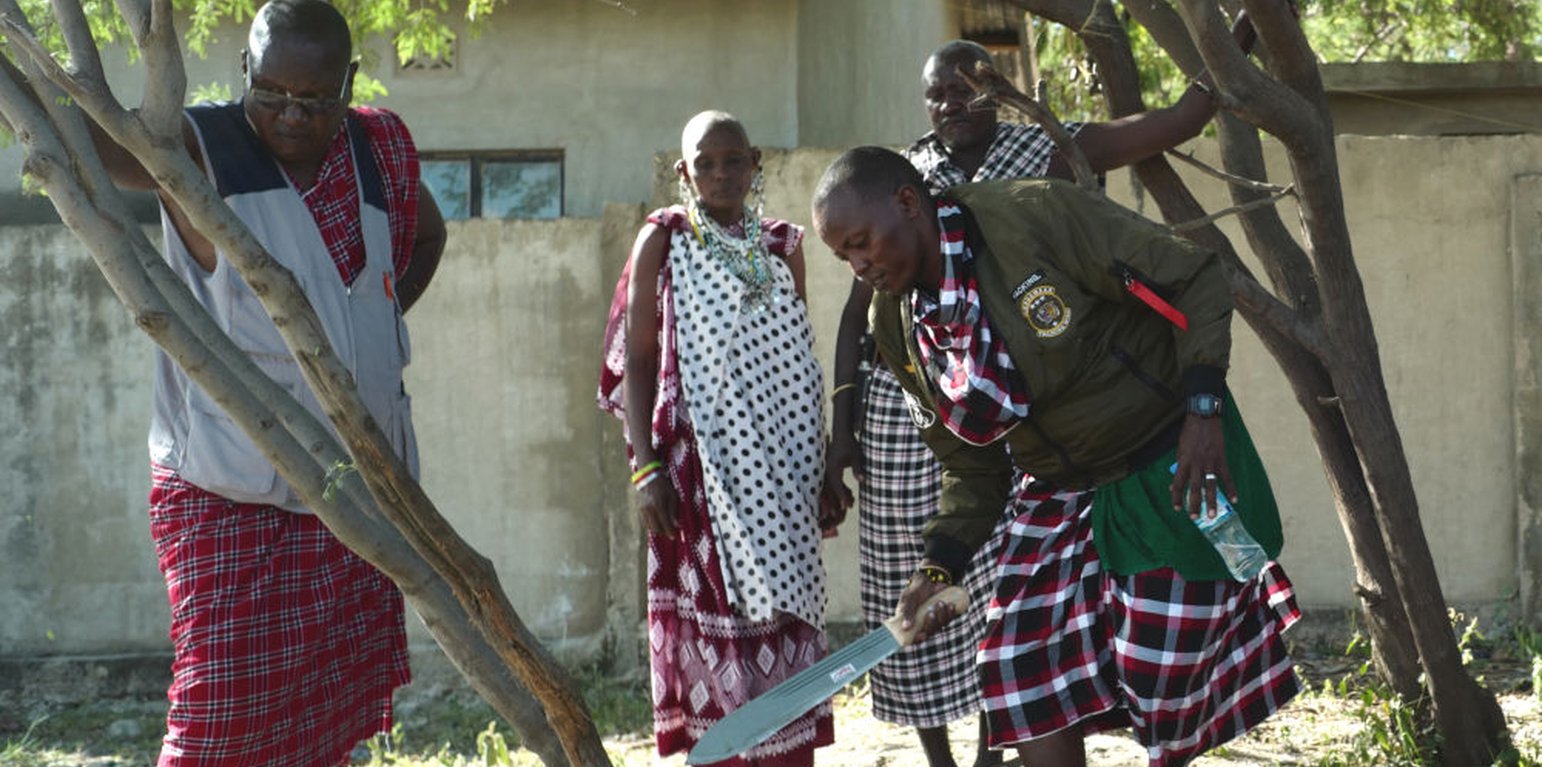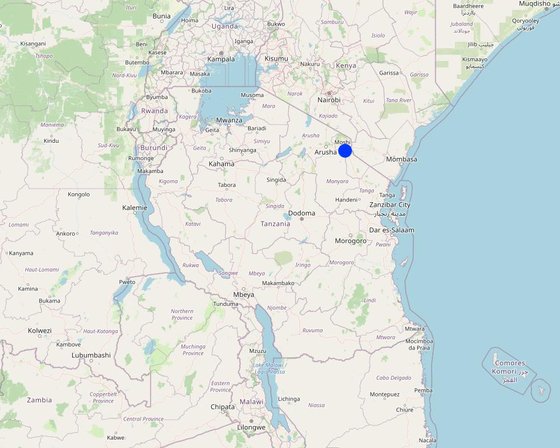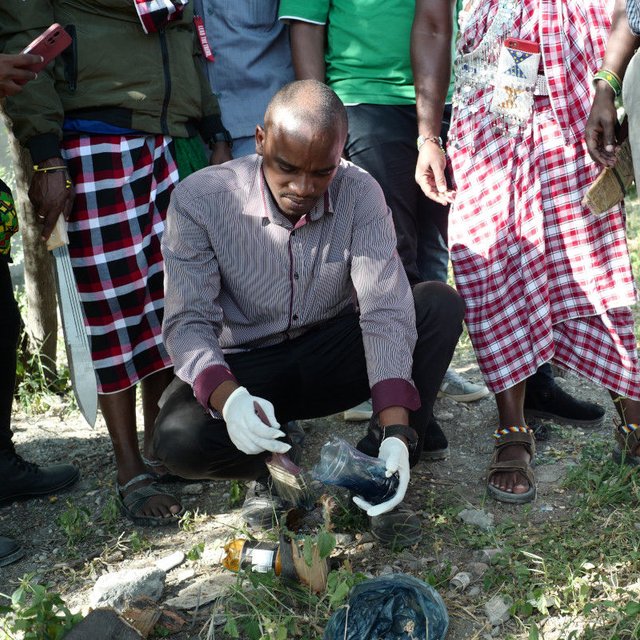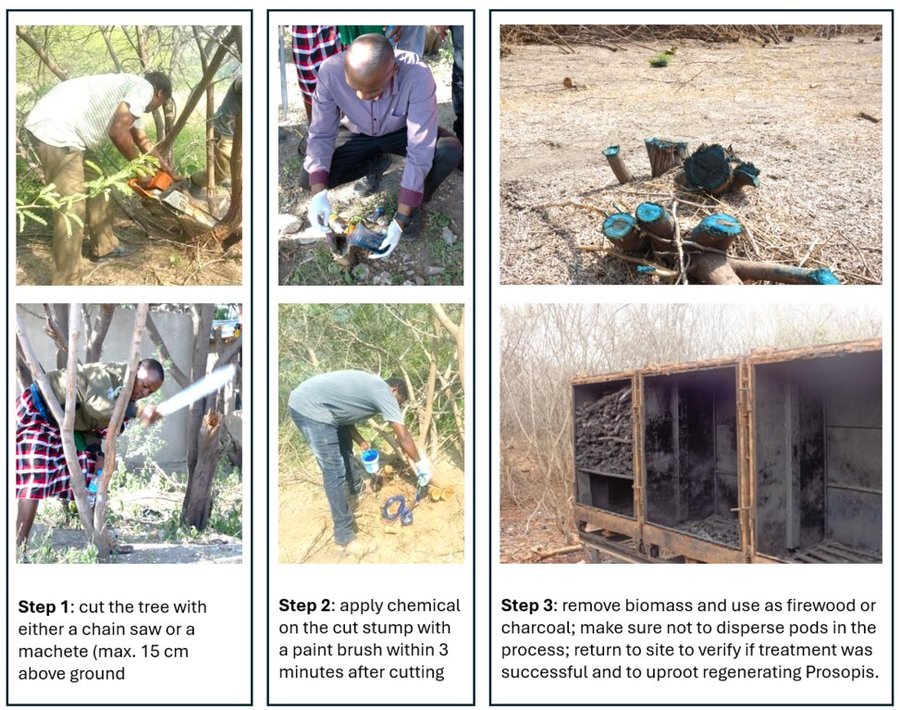



The technology is highly relevant and effective for controlling the invasion of Prosopis spp. in both agricultural and grassland areas where the species is considered problematic. It is particularly suitable for dry regions prone to Prosopis invasions, especially those experiencing drought periods of more than four months, which allow the herbicide to take significant effect. To avoid chemical contamination, the technology should only be applied in areas located more than 200 meters away from water sources.
This method requires simple tools to cut trees efficiently, with a chainsaw being recommended for the task. However, in areas where infestations cover less than 20 percent of the land, simpler tools such as machetes can be used. Trees should be cut as close to the ground as possible (no more than 15 cm stump height), and herbicide should be applied to the stump within three minutes of cutting. The treatment should be carried out during the dry season, ensuring no rainfall is expected within a month to allow for complete absorption of the herbicide.
A minimum of two people equipped with proper protective clothing is required for this operation: one to cut the trees and another to apply the herbicide and clear the cut branches. The herbicide, typically Triclopyr, is often mixed with diesel at a 1:50 ratio. A follow-up application is crucial to target any trees that were not completely killed during the initial treatment.
Herbicides can be ordered from Arysta Co. Ltd in Tanzania at a cost of TZS 1,000,000 (USD 430) per 20 liters. The advantages of using this technology include its effectiveness in killing the trees and the ability to utilize the cut branches as fuelwood or for making Prosopis charcoal. However, the major drawbacks include limited information leading to scepticism among land users regarding the health risks and potential long-term effects on soil quality, as well as the limited availability of the herbicide in local agro-stores.

Localização: Kahe, Kilimanjaro, República Unida da Tanzânia
Nº de sites de tecnologia analisados: 2-10 locais
Difusão da tecnologia: Aplicado em pontos específicos/concentrado numa pequena área
Em uma área permanentemente protegida?: Não
Data da implementação: 2017; menos de 10 anos atrás (recentemente)
Tipo de introdução


| Espécie | Contagem |
| gado - carne bovina não-láctea | 10 |



| Especifique a entrada | Unidade | Quantidade | Custos por unidade (Tanzanian Shilling) | Custos totais por entrada (Tanzanian Shilling) | % dos custos arcados pelos usuários da terra |
| Mão-de-obra | |||||
| Cutting of stems | Mandays | 2,0 | 20000,0 | 40000,0 | |
| Chemical application using paint brush | Mandays | 1,0 | 20000,0 | 20000,0 | |
| Separating intertwined branches | Mandays | 2,0 | 20000,0 | 40000,0 | |
| Removing small branches and debris | Mandays | 1,0 | 20000,0 | 20000,0 | |
| Equipamento | |||||
| Hiring a Chain saw | Hours | 8,0 | 4000,0 | 32000,0 | |
| Fertilizantes e biocidas | |||||
| Triclon (480g/l Triclopyr) | Litres | 1,2 | 50000,0 | 60000,0 | |
| Custos totais para a implantação da tecnologia | 212'000.0 | ||||
| Custos totais para o estabelecimento da Tecnologia em USD | 88.33 | ||||
| Especifique a entrada | Unidade | Quantidade | Custos por unidade (Tanzanian Shilling) | Custos totais por entrada (Tanzanian Shilling) | % dos custos arcados pelos usuários da terra |
| Mão-de-obra | |||||
| uprooting regenerating Prosopis | Mandays | 5,0 | 20000,0 | 100000,0 | |
| Fertilizantes e biocidas | |||||
| Triclon (triclopyr 480g/L) | Litres | 0,6 | 50000,0 | 30000,0 | |
| Custos totais para a manutenção da tecnologia | 130'000.0 | ||||
| Custos totais de manutenção da Tecnologia em USD | 54.17 | ||||
Quantidade anterior à GST: 1 t/ha of maize
Quantidade posterior à GST: 1.5 t/ha of Maize
A significant increase was seen in maize production but also the production of tomatoes increased by about 25%.
Quantidade anterior à GST: 4 loads@ 10kg
Quantidade posterior à GST: 15 loads@ 10kg
A significant increase in fodder production due to reduced competition with Prosopis and increased production area.
Quantidade anterior à GST: 30 bags @ 20kg
Quantidade posterior à GST: 0 bags
Absence of wood products was due to the removal of Prosopis. Wood from Prosopis was harvested after every 4 years, but with continuous application of the technology, no harvest is expected.
Quantidade anterior à GST: USD 260 per season
Quantidade posterior à GST: USD 470 per season
Income from harvests per season (about 4 months)
Quantidade anterior à GST: 1
Quantidade posterior à GST: 2
Only income from selling charcoal but after the application of the technology income is obtained from selling cereals and vegetables.
Quantidade anterior à GST: more than 10 injuries
Quantidade posterior à GST: 0 injuries
The technology has reduced incidences of injuries to both animals and humans from Prosopis thorns.
Quantidade anterior à GST: lesser than 10%
Quantidade posterior à GST: greater than 80%
Increased cover of preferred grass for pasture.
Quantidade anterior à GST: less than 5% of the village population
Quantidade posterior à GST: about 10% of the village population
10% of the village population (about 450 households) is now aware of SLM technologies to manage invasive plant species.